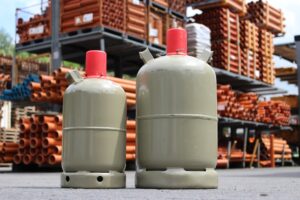Written on: April 10, 2019

Above-ground, residential propane tank
When it comes to above-ground and underground propane tanks many homeowners initially think of looks; to them, an above-ground tank can be an eyesore. However, when it comes to deciding whether an above or underground propane tank is best for your home, there are several factors to consider apart from sheer aesthetics.
Specifically, the differences between cost, installation, and safety should be a priority for homeowners. Consider the following as you make your decision.
For an above-ground tank, the majority of the cost is in the purchase of the tank itself. And, the price of a propane tank will vary depending on how many gallons you’d like it to hold.
As you can imagine, the larger the tank you select, the more it will cost. However, with an above-ground tank, there are fewer costs associated with installation than its underground counterpart. Additionally, because of the accessibility of an above-ground tank, on-going maintenance will also be a bit cheaper.
Before installing an above-ground propane tank, you must check off a few administrative items first. For instance, ensuring distance requirements have been met and necessary permits have been obtained are critical steps. Additionally, it may be necessary to lay a concrete pad or concrete blocks for the stability of the tank.
These items are routine and fairly easy to knock off the list before installation. Better yet, a reputable propane company can do the legwork for you.
Watch how simple it is to install an above-ground propane tank.
The safety of an above-ground tank versus an underground tank will boil down to the geographic location in most cases. While above-ground tanks are more exposed and vulnerable to extreme climates, making them less durable during severe conditions, if you’re in an area prone to flooding, an above-ground tank is usually the safer option.
That’s because an underground tank can actually float away from your home if the water rises above the propane level in your tank. An above-ground tank stands a few inches off the ground and is bolted down at the feet, making it more stable and less exposed during flooding conditions.
Additional factors might include its susceptibility to humans. Above-ground tanks can be targets for vandalism. Furthermore, if you’re located near a road, an above-ground tank may also be vulnerable to vehicle collisions.
Whether you select an above-ground or underground option, the physical tank will cost the same. However, an underground tank will be costlier upfront due to the extra expenses for:
These special requirements to install an underground tank can roughly double the cost of the installation of an above-ground propane tank.
Further, underground tanks can be costlier to maintain. Underground propane tanks require an anti-corrosion coating to protect against underground elements that could damage the outer material. To ensure the coating is working correctly, it must be inspected and tested on a regular basis. And, if the anti-corrosion coating has been compromised, it will need to be replaced. These maintenance measures will come at an additional cost to the homeowner.
Similar to an above-ground tank, it’s critical to have the proper permits, arrangements and safety checks conducted before starting excavation. Once excavation has started, the process of installing an underground propane tank will take between 2-3 hours.
If your home has a septic tank, you may need to contact your septic company to dig the hole for the underground propane tank. Without coordination, it’s possible that the propane delivery equipment will run over the septic tank, which can cause costly damages.
Watch this video to see what the installation process for an underground tank looks like:
Generally, underground tanks are safer than above-ground tanks. One reason is that it’s easier for these tanks to stay temperate in extreme weather, especially in the freezing cold.
Underground tanks are also safer in the event of a leak. Propane is a green fuel, so if a leak were to occur, rest assured it would not harm the local water or soil. Unlike an above-ground tank, there is no chance for the fuel to escape into the air, causing a fire hazard.
Therefore, depending on your weather conditions, an underground tank is a safer bet. The exception to this rule is in areas at risk of flooding, where above-ground tanks are preferred.
As you can see there are advantages and disadvantages of both above-ground and underground propane tanks. For aesthetics and safety, underground tanks most often take the cake. However, if you’re on a tight budget, or live in a flood-prone area, an above-ground tank may be more practical.
Whether you decide on an above-ground or underground propane tank, make sure you choose the right energy company to partner with for support while selecting, delivery, and maintaining your equipment.